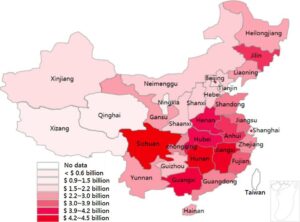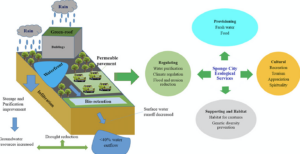Yaëlle Müller
Both climate change and urban growth are threatening the urban water management around the world. Climate change causes natural hazards to becoming more common. These extreme weather events include flooding disasters and water shortage (Parker, 1978). In 2014, China implemented a new strategy to strengthen sustainable stormwater management: Sponge Cities.
The case of China
The world’s most populated country, China, has been greatly affected by flooding caused by extreme rainfall in the last decade. Cities including Beijing, Shanghai, Wuhan and many others have been particularly hit by these extreme events (Jiang, Zevenbergen, & Ma, 2018). The figure below shows the economic loss caused by urban flooding in China in 2013.

Figure 60.1 – Figure 1: economic loss due to urban flooding in different provinces of China (Jiang et al., 2018)
According to Yong Jiang from the IHE Institute for water education, China’s urban pluvial flood disaster has been a consequence of the following factors: climate change, urbanization, urban development practice and pattern and finally urban stormwater management. Urbanization increases societal exposure to hazards induced by climate change (Jiang et al., 2018).
Moreover, the Chinese urban development practices haven’t paid enough attention to ecological aspects of urbanization, thus many ecosystems and their functions have disappeared. Consequently, there is less absorption capacity for water, and it is therefore constrained to stay at the surface. China’s urban drainage systems are insufficient and haven’t been able to keep up with the rapid pace of urbanization (Jiang et al., 2018).
The implementation of sponge cities
China planned a national urbanization plan towards sustainable development between 2014 and 2020. Water was at that time and still is seen as the most critical resource in china. In fact, about 45% of Chinese cities are subject to insufficient water supply. That is the context in which the project of sponge cities emerged. Essentially, the initiative is a planning and design strategy for urban development that promotes rainwater systems integrated with strategic ecosystem conservation and restoration or remediation (Jiang et al., 2018).
Urbanization which is necessary for China is directly dependent on available water resources. The initiative is very similar to other stormwater-management projects across the world (such as low-impact development in the US or urban drainage systems in the UK). The SCI (sponge cities initiative) reflects the modern understanding of tackling urban water issues in a holistic, sustainable way, consistent with integrated urban water management. China implemented sponge cities in 2014 by selecting 16 pilot cities in which the project was implemented. In 2016, 14 more cities were added to the list (Jiang et al., 2018) .
Several stakeholders have been and still are involved on the SCI. The Chinese government is coordinating the work of other official bodies. The National Development and Reform Commission (NDRC) has been responsible for collecting financial support for the construction. The Ministry of Finance has allocated and managed funds for each pilot project. The Ministry of Urban Housing (MOHURD) has issued guidelines and standards for sponge city implementation as well as supervised pilot projects. The task of the Ministry of Water Resources is to guide Sponge Cities’ water conservation aspects. Stakeholders that work at the local government level have been given the task of planning and implementing of Sponge City projects in their jurisdictions. The close cooperation of various levels of government administration was and still is a vital factor for successful implementation of the SCI (Jiang, Zevenbergen, & Fu, 2017).
What are sponge cities?
Sponge cities aim to include the use of natural processes such as soil and vegetation as part of the urban runoff control strategy of urbanized cities. The benefits of these cities include alleviation of urban flooding, water resources shortage, and the urban heat island effect as well as improvement of the ecological environment and biodiversity by absorbing and capturing rain water and utilizing it to reduce floods (Delaney, 2018).
The development of sponge cities must meet the 3 following criteria: ecosystems protection, ecological restoration measures and low-impact development. Firstly, urban ecosystems such as lakes, rivers and soils are gradually being protected and treated by microorganisms and natural vegetation as to restore the natural urban ecosystem. Ecological restoration measures include the construction of corridors and formation of an ecological network within the city in order to maintaining important ecological functions. Finally low impact development strengthens sustainable measures applied to urban infrastructures such as roads and buildings (Liu, 2020).

Figure 60.2 – Figure 2: Schematic representation of sponge cities (Nguyen et al., 2019)
The challenges of sponge cities
Urban stormwater management is complex and represents one of the main challenges for the initiative. New technologies emerge every day and facilities must always evolve accordingly. With the ecological dimension being added, and the uncertainties caused by climate change, water management has become a really complex system (Jiang et al., 2018).
China focuses on the implementation of technological and scientific solutions. However only little attention is given to scientific research, capacity building and education, and knowledge sharing, which all are important elements enabling the implementation of the SCI (Jiang et al., 2018).
Another challenge lies in the coordination of the project and the divergence between the expectations and needs of different stakeholders. In urbanized areas, social, ecological and infrastructure systems are interconnected and often governed by overlapping and intersecting administrative boundaries of diverse local government agencies. It can thus be difficult, to reach an agreement without an institutional network (Morison & Brown, 1990).
Costs play a tremendous role when it comes to implementing a project. Preliminary estimation indicated a required investment of approximately US$ 15–22 million for each square kilometer and there is no clear answer how the investments will evolve in the future. The planned investments for the pilot cities last only for 3 years. Furthermore, a private financial investment can be difficult when it comes to sponge cities implementation, because they are categorized as public goods (Jiang et al., 2017).
Finally, monitoring, information support and project evaluation play a tremendous role in the maintenance of such a project. From an economical point of view collection of costs and benefits is necessary to target inefficiencies and to develop new solutions to solve them. Moreover, monitoring is also important in order to justify the need of financial support (Jiang et al., 2017).
Conclusion
China has developed an innovative project in order to cope with the numerous changes caused by global warming and almost exponential urbanization of its country. However, many challenges arise in the framework of the implementation of sponge cities and the future remains uncertain. Globally, the sponge cities initiative can be seen as a step towards sustainable development and adaptation to the climate change dominated future.
Bibliography
Delaney, B. (2018). Turning cities into sponges: how Chinese ancient wisdom is taking on climate change | Design | The Guardian. Abgerufen 9. Mai 2022, von https://www.theguardian.com/artanddesign/2018/mar/21/turning-cities-into-sponges-how-chinese-ancient-wisdom-is-taking-on-climate-change
Jiang, Y., Zevenbergen, C., & Fu, D. (2017). Understanding the challenges for the governance of China’s «‹sponge cities›» initiative to sustainably manage urban stormwater and flooding. Natural Hazards, 89. https://doi.org/10.1007/s11069-017-2977-1
Jiang, Y., Zevenbergen, C., & Ma, Y. (2018). Urban pluvial flooding and stormwater management: A contemporary review of China’s challenges and “sponge cities” strategy. Environmental Science and Policy, 80, 132–143. https://doi.org/10.1016/J.ENVSCI.2017.11.016
Liu, J. (2020). Xiamen: Adapting to Climate Change with Sponge City Construction – Sino-German Cooperation on Climate Change, Environment, and Natural Resources. Abgerufen 9. Mai 2022, von https://climatecooperation.cn/urbanisation/xiamen-adapting-to-climate-change-with-sponge-city-construction/
Morison, P. J., & Brown, R. R. (1990). Journal of Environmental Planning and Management Avoiding the presumptive policy errors of intergovernmental environmental planning programmes: a case analysis of urban stormwater management planning. https://doi.org/10.1080/09640560903529329
Nguyen, T. T., Ngo, H. H., Guo, W., Wang, X. C., Ren, N., Li, G., … Liang, H. (2019). Implementation of a specific urban water management – Sponge City. Science of The Total Environment, 652, 147–162. https://doi.org/10.1016/J.SCITOTENV.2018.10.168
Parker, D. J. (1978). Floods in Cities: Increasing Exposure and Rising Impact Potential. Hazards in the Built Environment, 21(3), 114–125. Abgerufen von https://www.jstor.org/stable/23289009